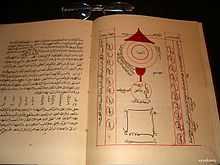Muhammad Ghawth
- See Ghaus Mohammad for the tennis player who reached the Wimbledon quarterfinals in 1939
Muhammad Ghawth (Ghouse,[1] Ghaus or Gwath[2][3]) Gwaliyari was a 16th-century Sufi master of the Shattari order and Sufi saint, a musician,[4] and the author of Jawahir-i Khams (Arabic: al-Jawahir al-Khams, meaning the Five Jewels).
Biography
Muhammad Ghawth Gwaliyari was a son of Sayyid Hazir al-Din (misspelled Khatir al-Din) Bayazid, son of Khawajah Farid al-Attar, son of Sima Wasil, son of Ahmad al-Sadiq, son of Najibuddin Taqiyuddin, son of Nur Allah Abu Bakr al-Ajli, son of Isma'il ibn Jafar, son of Ja'far al-Sadiq, son of Muhammad al-Baqir, son of Zayn al-Abidin, son of Husain ibn Ali, son of Ali ibn Abi Talib.
He was born probably in 906 AH (1500 CE)
In the preface of al-Jawahir al-Khams, he states that he wrote the book when he was 25 years old. In 956 A.H. (1549 CE) he travelled to Gujarat, when he was 50 years old. He stayed in Ahmedabad for ten years where he founded Ek Toda Mosque and preached.[5]
Among Ghawth's disciples is Fazl Allah Shattari (also known as Shah Fazl Shattari),[6] who wrote a biography[7] or monograph[8] in praise of his teacher.[8] Gwawth taught the Mughal Emperor Humayun,[9][10] and was also a tutor of the Mughal Emperor Akbar's favorite musician, Tansen. It is uncertain whether Tansen was tutored in Sufism, in music or in both, but Tansen was familiar with Sufism.[4] Badusha, Abdul Qadir, Shahul Hamid Meeran sahib Ganjasavoy Ganja bakhsh Ganja makhfi of nagore Tamil Nadu is also one his important disciple. Muhammad Ghawth died in 1562 CE.[10] Ghawth's tomb, in Gwalior (a city in Madhya Pradesh in India), which was built in his honour by Akbar,[10] is a well-known tourist attraction and regarded as an excellent example of Mughal Architecture. Tansen was buried in Ghawth's tomb complex.[4]
Works

- Jawahir-i-Khamsa (The five jewels) which was later translated to Arabic, al-Jawahir al-Khams, by the Mecca-based Shattari teacher Sibghat Allah (d. 1606 CE).
- Bahr al-Hayat (The Ocean of Life), his translation of Hawd al-Hayat (The Pool of Life), an Arabic translation of Amrtakunda, a book on Yoga, written in Sanskrit.
Notes
- ↑ Shattari lineage
- ↑ Idries Shah, The Sufis ISBN 0-86304-020-9 Octagon Press 1989 pp 335, 367
- ↑ Idries Shah, Tales of the Dervishes ISBN 0-900860-47-2 Octagon Press 1993 pp 111-112
- ↑ 4.0 4.1 4.2 Wade, Bonnie C. (1998). Imaging Sound: An Ethnomusicological Study of Music, Art, and Culture in Mughal India (Chicago Studies in Ethnomusicology). University Of Chicago Press. pp. 113–115. ISBN 0-226-86840-0. See google book search.
- ↑ Achyut Yagnik (2 February 2011). Ahmedabad: From Royal city to Megacity. Penguin Books Limited. p. 42. ISBN 978-81-8475-473-5.
- ↑ Ernst, Carl W. (1996). "Sufism and Yoga according to Muhammad Ghawth" (PDF). University of North Carolina. Retrieved 2009-08-05. Reproduced from Sufi 29 (Spring 1996), pp 9-13.
- ↑ Chopra, Dr. Pran Nath (editor) (1976). "Life and Letters Under the Mughals". Ashajanak Publications (New Delhi). Retrieved 2009-08-05. See Open library details.
- ↑ 8.0 8.1 Hadi, Nabi (1998). Dictionary of Indo-Persian literature. Abhinav Publications. pp. 178–179. ISBN 81-7017-311-6. See google book search.
- ↑ Yasin, Mohammad (1988). Reading in Indian History. Atlantic Publishers & Distributors (New Delhi). p. 42. No ISBN. ASIN: B0006ERVCA.
- ↑ 10.0 10.1 10.2 Hastings, James (author) and Selbie, John A. (editor) (2003). Encyclopedia of Religion and Ethics, Part 21. Kessinger Publishing, LLC. p. 69. ISBN 0-7661-3700-7. See google book search.
